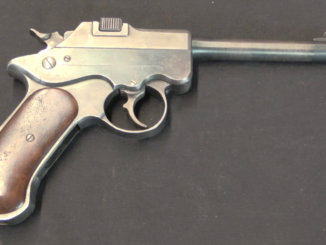This transferrable Model 6 SMG is being sold at Morphys on October 30, 2018.
Before he made a big success with the M10 (MAC-10) submachine gun, Gordon Ingram designed a couple other guns. His initial M5 submachine gun and M20 light machine gun never went past prototype stage, but the M6 did prove to be successful, at least in a limited way. The M6 was a very simple blowback .45ACP submachine gun very deliberately made to look like the Thompson. It was introduced in 1948, and in 1949 Ingram and other investors created the Police Ordnance Company to market and sell it. A total of about 2,000 were made, including an order of 400 to the Peruvian government which was coupled with a licensing agreement which would see some 8,000 more produced in Peru on license.
The Model 6 was offered in three calibers, but only the .45 ACP saw any sales (the other options were 9x19mm and .38 Super). Three configurations were detailed in the company’s marketing literature, although in production guns some of the features were mixed. The official models were the Police (finned barrel and vertical front grip), Guard (smooth barrel and horizontal front grip), and Military (smooth barrel, fully hooded sight, sling swivels, and spike bayonet). Production on lasted for a few years, as Ingram left the company in 1953 and it dissolved in 1954. Today, Model 6 submachine guns are a neat and under recognized piece of Ingram history, completely overshadowed by the M9, M10, and M11 designs which Ingram would produce later.




Not enough room for the M6 on the private sector as wartime surplus guns were everywhere, huh?
In this case, Ingram was just late. Would this design appear in 1930s, then “economical” Thompson might be success for time of Great Depression, would it appear few years later it might be adopted instead of Hyde-Inland M2. But sometimes even less than few years make big difference: http://polandballcomics.tumblr.com/post/151651344101/king-of-the-air-via-reddit
But to be honest, it must be said that he was on time with MAC 10, which is contemporary Steyr MPi 69.
The Police Dept. that I retired from Used to have one of these guns in a display case in it’s indoor firing range. Obviously I would have loved to have had a chance to fire it.
I wonder what price the M6 went for? It would be hard to undercut an M3 at $20, but of course they were not for sale to police and prisons when this was made.
Can someone explain why magazine design seems
to be such a problem/issue? It looks like a rather simple piece to produce but there is obviously something I’m missing. Why do some firearms manufacturers use other manufacturers magazines or designs?
Sure! First is feed lip geometry. Getting the correct feed lip geometry for a specific firearm requires an awful lot of R&D, then trial & error to get it working. Bolt velocity, feed ramp/breech chamfer, etc. all make this a rather involved process, especially before CAD. Then there’s the dies used to form the magazines. They have to be precision machined to ensure proper function, thus are expensive. Small companies can’t afford to remake them if the initial design doesn’t work properly, so sometimes a design slips through the cracks that’s not totally reliable. Internal geometry is also an issue. Getting a balance between maximizing round count & ensuring smooth elevation of the cartridge stack is tricky. If it’s a single feed, the merging of stacks can become problematic. Spring tension has to be taken into consideration – you don’t want the top rounds to be so tight the bolt loses momentum & doesn’t feed or the last few rounds to have such little tension they fail to rise in time to be caught by the bolt. Even the catch notch’s location on the magazine body effect how high the round sits in relation to the bore line. This can cause rounds to nose-dive or flip up. Lastly, you have metallurgy: the sheet steel needs to form well, yet maintain its shape.
In my experience, if a firearm fails to feed, it’s likely traceable to the magazine. (Discounting under-powered ammo that fails to cycle the action, of course!) There’s a LOT more to making a reliable firearm magazine than just making a box with a spring that you cram bullets into. Using an existing magazine has 2 benefits: 1) Your gun uses commonly available magazines 2) Many of the bugs are already worked out when using an existing design. Notice how all new MSR designs use AR pattern mags.
Today, large corporations have the capital to tinker with the design, re-making dies over & over again if necessary. Not only do they have access to the latest design software, they also have 100+ years of what works & what doesn’t & are thus able to make a firearm reliable upon introduction.
Hope this answers your questions!
“1) Your gun uses commonly available magazines 2) Many of the bugs are already worked out when using an existing design.”
Moreover, if new bigger magazine appears for original weapon, it can be also used in that other weapon.
Cf. aeroplane + engine combination, where also mostly already available engines are used, take for example Convair Tradewind, which although itself being structurally sound, served only for few years due to troublesome engines (Allison T-40)
https://en.wikipedia.org/wiki/Convair_R3Y_Tradewind
is: “(…)T-40(…)”
should be: “(…)Model 500(…)”
Yes, you are right! On top of that, magazines are made with different tools than most other firearm parts. Specialized companies make them. By using an existing design, you save a lot of money (economy of mass production, no new tools needed)
“something I’m missing”
[Following apply to FULL-AUTO (machine) weapons, so if you are asking about any other ignore this post]
Time. Lets assume Rate-of-Fire equal to 600 rpm, this mean 10 rounds per second or in other words 0.1 second between firing cartridge. Although it don’t have to be always true, we can for our needs assume that time of travel of moving parts between fully closed and fully opened position is equal to time of travel between fully opened and fully closed position. Therefore we can say that there is no more than of 0.05 second to index cartridge. Proportionally less for bigger Rate-of-Fire.
Also notice that in history of full-auto fire-arms/20th century, ability to load magazines using fingers alone was NOT always present. IIRC Lahti-Saloranta light machine gun required device to load magazine to full capacity (20).
It is common for manufacturers to use other Mags as they know they work so why bother reinventing the wheel? Also don’t forget that practically the entire NATO/MIL range of weapons share the same Mags. Makes sense really.
Thing is, very often magazines are simply used because they are available. Not because they work all that good. The French made very many SMG prototypes with the MP40 magazine. The Sten gun magazine–principal source of stoppages with that unlovely and unloved weapon–continued to be used by a host of other designs in spite of its flaws. It is my understanding–flawed perhaps–that the Sten was designed so that the MP40 magazine could be used with it, but not vice-versa… Still waiting for confirmation of that.
The MAC-10 of course could use M3 Grease gun mags, which finally became more available! Uzi magazines also appeared frequently in similar/kindred SMG designs.
” It is my understanding–flawed perhaps–that the Sten was designed so that the MP40 magazine could be used with it, but not vice-versa… Still waiting for confirmation of that.”
It’s a fantasy,
Sten magazine is wider front to back, and that is because of the space filling rib in the back tied to the before used different, longer cartridge,
anyway story that explains it, exists on the internet, too lazy to search for it now.
It saves a lot of time and money during development if you can use off-the-shelf parts. Consider that it can take days or weeks for a machinist to tool up and machine a single new part for your prototype. It can also easily cost ten times as much.
Another reason not mentioned is that the box magazine was invented in the 1800s and any patents would be expired. This means that a manufacturer may spend lots of resources designing a reliable magazine for a given cartridge, but there is no new geometry to patent, just different dimensions. Anyone can then copy the magazine and sell it as their own, or design a gun around the magazine. In this regard, if you design a box magazine, you’re spending your own resources to the benefit of your competitors.
Is it just me, or is the Ingram M6 having a really slim receiver, and a tiny bolt? Or am I being fooled by the size of it’s barrel, furniture and lower receiver?
Thank you all for your informative replies. I appreciate the scholarship every time I ask a question. You are most helpful.
Hey! Where’s the full-auto shoot video of the Model 6? It’s been two days now and no joy.
I cannot find any information about the m20 and its really bugging me. Where can I find some diagrams or photos of it?
The Mac Man has the only data I could find on it. Honestly it only has a few paragraphs worth of data. Start there and try the sources of the photos that are in it. Maybe they have more info. It is my understanding though that the prototype no longer exists.
Hmm, how come post on this video is not on the front page ?
I’ve seen it only in youtube, and need to search for it here.
As for model 6, web mentions progressive trigger, Ian is silent on it, was it not present on this very model from video ?